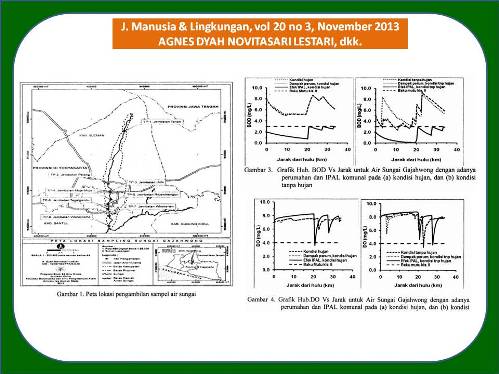
APLIKASI MODEL QUAL2Kw UNTUK MENENTUKAN STRATEGI PENANGGULANGAN PENCEMARAN AIR SUNGAI GAJAHWONG YANG DISEBABKAN OLEH BAHAN ORGANIK (Aplication of Qual2Kw Model to Determine the Strategy in Solving Gajahwong River Water Pollution Caused by Organic Matter)
Agnes Dyah Novitasari Lestari(1*), Eko Sugiharto(2), Dwi Siswanta(3)
(1) Jurusan Kimia, Fakultas MIPA, Universitas Negeri Papua, Manokwari
(2) Jurusan Kimia, Fakultas MIPA, Universitas Gadjah Mada, Yogyakarta
(3) Jurusan Kimia, Fakultas MIPA, Universitas Gadjah Mada, Yogyakarta
(*) Corresponding Author
Abstract
ABSTRAK
Telah dilakukan pemodelan kualitas air terhadap Sungai Gajahwong menggunakan model QUAL2Kw untuk parameter DO-BOD. Diselidiki dinamika DO-BOD sungai tersebut pada kondisi eksisting tahun 2011. Oleh karena beban pencemar pada kondisi hujan dan tanpa hujan berbeda, maka prediksi dilakukan pada kedua kondisi tersebut. Hasil pemodelan QUAL2Kw untuk kondisi eksisting Sungai Gajahwong tahun 2011 menunjukkan bahwa pada kondisi hujan dan tanpa hujan, konsentrasi BOD sungai telah melebihi bakumutu air kelas II. Hasil simulasi menunjukkan bahwa (1) Pembangunan perumahan yang membuang limbah cairnya ke Sungai Gajahwong pada debit total 0,1 m3/s dengan konsentrasi BOD 10 mg/L dapat meningkatkan BOD serta menurunkan DO Sungai Gajahwong, dan (2) Pengelolaan kualitas air dan penanggulangan pencemaran air oleh bahan organik pada Sungai Gajahwong dapat dilakukan dengan strategi pembuatan IPAL komunal di setiap kabupaten dengan penurunan konsentrasi BOD hulu hingga 2 mg/L.
ABSTRACT
Water quality modelling of Gajahwong River has been done using QUAL2Kw model for DO-BOD parameters. The dynamics of DO-BOD of the river on the existing conditions in 2011 has been investigated. Because of the load of pollutants in the rainy condition and no rain condition was different, then the predictions made on both conditions. QUAL2Kw modelling results for Gajahwong River in year 2011 showed that the BOD concentration of the river on both conditions has exceeded water quality standards class II. The simulation results showed that: (1) Housing construction that discharge its liquid waste into Gajahwong River on total discharge 0,1 m3/s with concentration of BOD 10 mg/L, increased the BOD and decreased the DO of Gajahwong River, and (2) Water quality management and organic pollution control of Gajahwong River can be done by a strategy of making communal WWTP in each district with reduction of the upstream BOD concentration to 2 mg /L.
Keywords
Full Text:
Artikel lengkap (PDF) (Bahasa Indonesia)Article Metrics
Refbacks
- There are currently no refbacks.
Copyright (c) 2017 Jurnal Manusia dan Lingkungan







